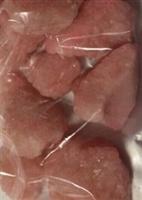(S)-N-Carbobenzyloxy-4-amino-2-hydroxybutyric acid
Min.Order / FOB Price:Get Latest Price
| 1 Kilogram |
FOB Price:USD 200.0000 -300.0000 |
- Min.Order :1 Kilogram
- Purity: 98%
- Payment Terms : L/C,T/T,
Keywords
(S)-N-Carbobenzyloxy-4-amino-2-hydroxybutyric acid L--a-Hydroxy-BenzyloxycarbonylaminoButyricAcid(CBZ-HABA) (S)-CBZ-HABA
Quick Details
- Appearance:white powder
- Application:Synthesis of Amikacin of APIs and intermediates
- PackAge:according to your request
- ProductionCapacity:10|Metric Ton|Month
- Storage:sealed in a vantilated place
- Transportation:shipping / air
Superiority:
Product name(S)-N-Carbobenzyloxy-4-amino-2-hydroxybutyric acidSynonyms
(S)-2-Hydroxy-4-[[(phenylmethoxy)carbonyl]amino]butyric acid
EINECS No.254-892-3
CAS No.40371-50-4
Molecular weight253.25
Molecular FormulaC12H15NO5
Appearance powder
Assay 98%
| Name: | (S)-N-Carbobenzyloxy-4-Amino-2-Hydroxybutyric Acid 96% Material Safety Data Sheet |
| Synonym: | None Known |
| CAS: | 40371-50-4 |
Synonym:None Known
Section 2 - COMPOSITION, INFORMATION ON INGREDIENTS
| CAS# | Chemical Name | content | EINECS# |
| 40371-50-4 | (S)-N-Carbobenzyloxy-4-Amino-2-Hydroxy | 96% | 254-892-3 |
Risk Phrases: None Listed.
Section 3 - HAZARDS IDENTIFICATION
EMERGENCY OVERVIEW
The toxicological properties of this material have not been fully investigated.
Potential Health Effects
Eye:
May cause eye irritation.
Skin:
May cause skin irritation.
Ingestion:
May cause irritation of the digestive tract. The toxicological properties of this substance have not been fully investigated.
Inhalation:
May cause irritation of the respiratory tract with burning pain in the nose and throat, coughing, wheezing, shortness of breath and pulmonary edema. The toxicological properties of this substance have not been fully investigated. Inhalation may be fatal as a result of spasm, inflammation, edema of the larynx and bronchi, chemical pneumonitis and pulmonary edema.
Chronic:
No information found.
Section 4 - FIRST AID MEASURES
Eyes: Flush eyes with plenty of water for at least 15 minutes, occasionally lifting the upper and lower eyelids. Get medical aid.
Skin:
Get medical aid. Flush skin with plenty of water for at least 15 minutes while removing contaminated clothing and shoes. Wash clothing before reuse.
Ingestion:
Never give anything by mouth to an unconscious person. Get medical aid. Do NOT induce vomiting. If conscious and alert, rinse mouth and drink 2-4 cupfuls of milk or water. Wash mouth out with water.
Inhalation:
Remove from exposure and move to fresh air immediately. If not breathing, give artificial respiration. If breathing is difficult, give oxygen. Get medical aid.
Notes to Physician:
Section 5 - FIRE FIGHTING MEASURES
General Information:
As in any fire, wear a self-contained breathing apparatus in pressure-demand, MSHA/NIOSH (approved or equivalent), and full protective gear. During a fire, irritating and highly toxic gases may be generated by thermal decomposition or combustion. Runoff from fire control or dilution water may cause pollution.
Extinguishing Media:
Use foam, dry chemical, or carbon dioxide. Use agent most appropriate to extinguish fire.
Section 6 - ACCIDENTAL RELEASE MEASURES
General Information: Use proper personal protective equipment as indicated in Section 8.
Spills/Leaks:
Vacuum or sweep up material and place into a suitable disposal container. Clean up spills immediately, observing precautions in the Protective Equipment section. Avoid generating dusty conditions.
Provide ventilation.
Section 7 - HANDLING and STORAGE
Handling:
Wash thoroughly after handling. Use with adequate ventilation.
Minimize dust generation and accumulation. Avoid breathing dust, vapor, mist, or gas. Avoid contact with eyes, skin, and clothing.
Keep container tightly closed. Avoid ingestion and inhalation.
Storage:
Store in a tightly closed container. Store in a cool, dry, well-ventilated area away from incompatible substances.
Section 8 - EXPOSURE CONTROLS, PERSONAL PROTECTION
Engineering Controls:
Facilities storing or utilizing this material should be equipped with an eyewash facility and a safety shower. Use adequate ventilation to keep airborne concentrations low.
Exposure Limits CAS# 40371-50-4: Personal Protective Equipment Eyes: Wear appropriate protective eyeglasses or chemical safety goggles as described by OSHA's eye and face protection regulations in 29 CFR 1910.133 or European Standard EN166.
Skin:
Wear appropriate protective gloves to prevent skin exposure.
Clothing:
Wear appropriate protective clothing to prevent skin exposure.
Respirators:
Follow the OSHA respirator regulations found in 29 CFR 1910.134 or European Standard EN 149. Use a NIOSH/MSHA or European Standard EN 149 approved respirator if exposure limits are exceeded or if irritation or other symptoms are experienced.
Section 9 - PHYSICAL AND CHEMICAL PROPERTIES
Physical State: Solid
Color: Not available.
Odor: Not available.
pH: Not available.
Vapor Pressure: Not available.
Viscosity: Not available.
Boiling Point: Not available.
Freezing/Melting Point: 74-80 deg C
Autoignition Temperature: Not available.
Flash Point: Not available.
Explosion Limits, lower: Not available.
Explosion Limits, upper: Not available.
Decomposition Temperature:
Solubility in water:
Specific Gravity/Density:
Molecular Formula: C12H15NO5
Molecular Weight: 253.1087
Section 10 - STABILITY AND REACTIVITY
Chemical Stability:
Stable at room temperature in closed containers under normal storage and handling conditions.
Conditions to Avoid:
Incompatible materials.
Incompatibilities with Other Materials:
Oxidizing agents.
Hazardous Decomposition Products:
Nitrogen oxides, carbon monoxide, irritating and toxic fumes and gases, carbon dioxide.
Hazardous Polymerization: Has not been reported
Section 11 - TOXICOLOGICAL INFORMATION
RTECS#:
CAS# 40371-50-4 unlisted.
LD50/LC50:
Not available.
Carcinogenicity:
(S)-N-Carbobenzyloxy-4-Amino-2-Hydroxybutyric Acid - Not listed by ACGIH, IARC, or NTP.
Section 12 - ECOLOGICAL INFORMATION
Section 13 - DISPOSAL CONSIDERATIONS
Dispose of in a manner consistent with federal, state, and local regulations.
Section 14 - TRANSPORT INFORMATION
IATA
Not regulated as a hazardous material.
IMO
Not regulated as a hazardous material.
RID/ADR
Not regulated as a hazardous material.
Section 15 - REGULATORY INFORMATION
European/International Regulations
European Labeling in Accordance with EC Directives
Hazard Symbols: Not available.
Risk Phrases:
Safety Phrases:
S 24/25 Avoid contact with skin and eyes.
WGK (Water Danger/Protection)
CAS# 40371-50-4: No information available.
Canada
None of the chemicals in this product are listed on the DSL/NDSL list.
CAS# 40371-50-4 is not listed on Canada's Ingredient Disclosure List.
US FEDERAL
TSCA
CAS# 40371-50-4 is not listed on the TSCA inventory.
It is for research and development use only.
Details:
CHENGDU YANXI is a comprehensive manufacturer and an international distribution of products throughout the world. Specialized in Scrap metal, Chemical raw materials, Paper products and color industry. We aim to become leading position in global distribution and trading based on a rather unique combination of technical skill, unrivalled supplier network, market knowledge and an absolute commitment to customer satisfaction.





You Might Also Like
Related Searches
About|Contact|Cas|Product Name|Molecular|Country|Encyclopedia
Message|New Cas|MSDS|Service|Advertisement|CAS DataBase|Article Data|Manufacturers | Chemical Catalog
©2008 LookChem.com,License: ICP
NO.:Zhejiang16009103
complaints:service@lookchem.com Desktop View